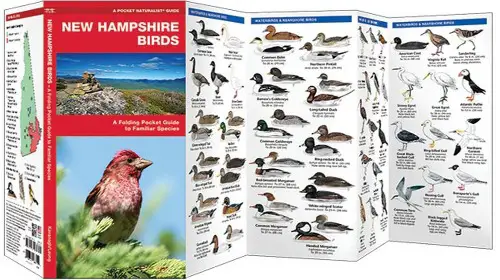Getting into birdwatching is fun and easy; you can get started without spending a considerable fortune. You can do it anywhere, even in your backyard.
So...
Whether you're a resident or visiting New Hampshire, the place is sure to offer you easy access to various birdwatching hotspots. There's a rich avian life in the state, from the seacoast to the mountaintops, lakes, and forests.
It may not be as sizable as the other states, but it is an excellent birdwatching destination. Hence, let's learn more about the New Hampshire birds, from nesting to migration and winter survival.
Familiar Backyard Birds In New Hampshire
There are many serene spots in the state where even an afternoon stroll in the woods can be satisfying. It is a rewarding experience for any birding enthusiast across the globe to see these feathered creatures migrating north after spending their winter in the south.
It's mesmerizing even to view the seasonal plumage transformation or hear a bird's enchanting song piercing through an otherwise quiet landscape. The abundant wildlife habitats in the region, from the boreal forests to wetlands, offer exceptional biodiversity to the birds in NH.
The black pileated woodpecker with red and white markings and the bright yellow northern flicker are some of the other birds frequenting the beach. Even the olive green red eyed vireo, often mistaken for the blue headed vireo bird, is among the common birds in the state.
State parks and seacoasts allow an excellent view of the shorebirds; wildlife viewing gets more exciting as eagles, ospreys, and other birds frequent the wetlands. The boreal forests host other songbirds, and the extreme northern areas deliver year-round birding opportunities.
Moreover, you witness raptor migration in the state's southwest region. All these and so much more are why many people find NH as every birdwatcher's paradise.
1. Black Capped Chickadee
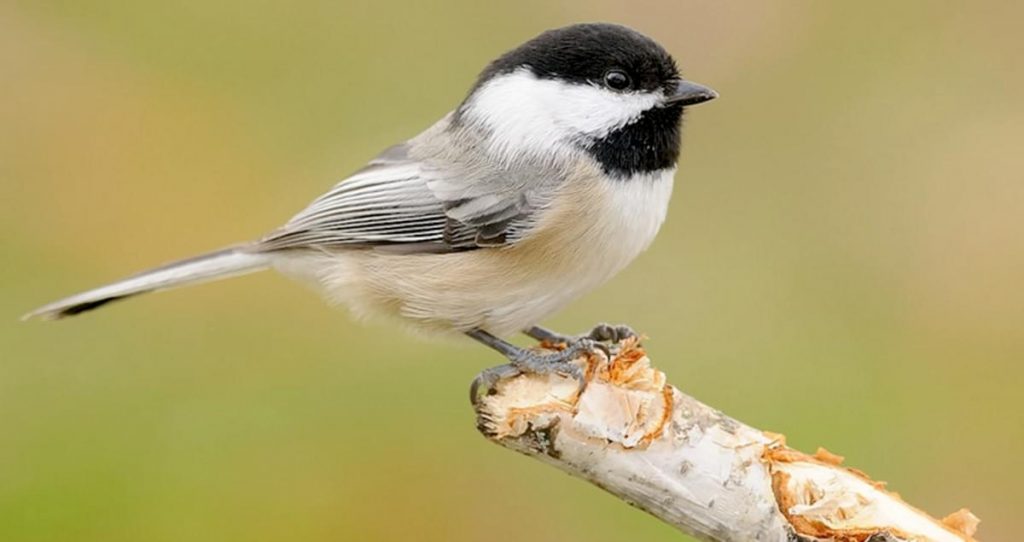
The black capped chickadee is a bird species belonging to the order of Passeriformes and Paridae family and has an extensive vocal range. The clever bird uses its vocalization skills by throwing its voice as it calls to divert and evade predators.
It has a sizable head, a small and compact body, a black cap, white-edged gray wing feathers, a black bib, and a pale gray back.
Black capped chickadees are not dull creatures; they are persistent and charming. Songs of this bird sound like the chickadee is saying its name in a pure whistling tone.
It's fun to hear birds singing their best tunes when spring arrives, and not everyone hears the same thing from different species.
Besides, listening to chattering chickadees can help you locate other species they often travel with, like the nuthatches, woodpeckers, and the pale yellow warblers.
You will gain more insights about its feeding habits if you observe the black capped chickadee closely. You might find it darting in to grab and munch on some black oil sunflower seeds from your bird feeder. Its stout beak is perfect for cracking seeds.
Moreover, this chickadee feels at home in almost every woodland type, like mixed and deciduous forests, parks, and suburbs. It is a well-known creature that dwells near human habitation and benefits from supplemental feeding.
2. Blue Jay
A birdbath offering fresh, cool water can be the most irresistible bird-luring addition you can have in your garden, especially for the blue jays. Such a bird is a regular at backyard feeders; otherwise, you can find a blue jay in woodlands, farmlands, and city parks.
Consider planting berry-producing shrubs in your backyard, such as golden currant, elderberry, and buckthorn to entice blue jays into visiting your yard.
Shelled peanuts are a blue jay's favorite meal, although you may try mixing them with some seeds. You might chance upon the jay stashing a peanut from your bird feeder to eat later. The species are the only birds that can break open the shells of whole peanuts to eat the inside.
Aside from the blue jay, these shrubs form thickets that make excellent nesting sites for mourning doves, hairy woodpeckers, downy woodpeckers, house finches, wrens, and robins.
NH birds identification is more straightforward for such a creature; blue jays are unmistakable with their pointed crests. Unlike the Steller's jay with blue and black wings, blue jays are smaller and have paler underparts.
Jays are striking blue above and white to light gray underneath, with white and black stripes on their wings and noticeable white tail corners in flight. These birds also feature a black line from the head down to their throats.
3. Mourning Dove
Mourning doves are among the medium sized birds in New Hampshire that favor mature landscape trees, large evergreen, and deciduous shrubs for their nesting needs. These feathered creatures have slender bodies, their flight straight and swift.
Aside from its plump body, a male mourning dove has a pale brown to pinkish plumage with a long tail. It also sports a black bill, darker wings, and red to pinkish legs and feet. Contrarily, the female mourning dove has a pale brown overall with no pinkish hue on the face.
Male mourning doves fluff their feathers to seduce the females during the mating ritual.
They are primarily sedentary with seasonal movements when breeding and foraging. You'll even hear these males calling throughout the day from a low perch or hopping after the females with boisterous wing-clapping during their courtship displays. It gets more exciting as the male dove does a series of short runs as it chases the supposedly fleeing female.
Such doves also roost in large flocks, occasionally visiting rivers for a drink. Some studies show that the dove's seasonal use of ponds and rivers slightly increases in summer and starts going down sometime in September.
These doves are migratory; males often move farther north than females, probably in an attempt to go back to prime breeding sites.
Like other birds in New Hampshire, such a dove also feeds on a black oil sunflower seed but not exclusively. In backyard feeders, you might notice that the mourning dove strongly prefers fine-cracked corn, white proso, golden German millets, thistle, and safflower seeds.
Besides such a diet, this dove also feeds on grubs, ants, beetles, and tiny snails, ranging seasonally. These graceful birds likewise have varying lengths in their breeding seasons.
Further north, the breeding period is shorter, while it can take all year in far south and Central America. The doves prefer edge habitats or boreal and deciduous forests near urban settlements when wintering north.
This environment allows this bird to exploit the grain spill in farmyards or garden hand-out foods. However, this feathered beauty stays in an open country with scattered woodlots and nearby watering sites when spending winter farther south.
It nests both in natural and secondary habitats, including parks, plantations, gardens, and buildings throughout its southward range.
4. Song Sparrow
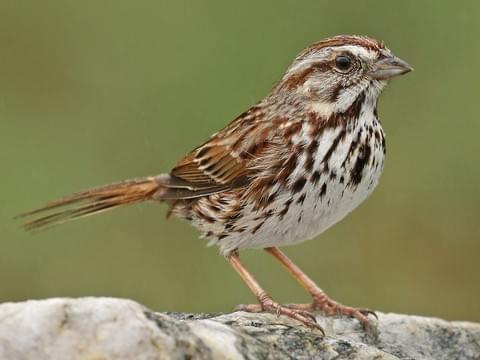
There are nearly thirty subspecies of song sparrows in North America, making such species the most geographically variable songbird. Additionally, the song sparrow is among the small birds in the state, but it is more sizable than the bright yellow goldfinches with black wings.
Such a bird has dark brown streaking on its white breast and flanks and has a long, rounded tail. Its reddish-brown and gray plumes look attractive, although such features vary throughout this sparrow's range; the subspecies from the east are more gray than reddish.
Despite the varying sizes, as much as the plumage color is, this songbird is about the same size as the red winged blackbirds.
It tends to inhabit forest edges, brushy areas, waterside thickets, parks, and beaches, favoring berries from thorny plants. Moreover, male song sparrows leave the nest to the females, which they prefer to have in thick cover or residential areas.
The female song sparrow uses grasses, weeds, and bark to build its cup-shaped nest, where it will lay colorful eggs. Such sparrows are ground nesters, making them more vulnerable to predator attacks from squirrels, skunks, raccoons, snakes, and house cats.
These songbirds are common in feeding stations outside of their breeding season; their short, rounded wings are why they can only be short to mid-distance migrants. Such a sparrow is well-known for exploiting black oil sunflower seeds at bird feeders with the dark eyed juncos.
Fun Fact: Aside from being diverse, sparrows also have an enduring lifespan. Research on how long do sparrows live to know more about this trait that these species have!
5. Downy Woodpecker
The Downy Woodpecker is among the state's most common backyard birds. Many birders often confuse this bird with the hairy woodpecker, but the downy is smaller and with a shorter bill.
You will effortlessly recognize this woodpecker with black wings and white patches. Its head has black and white stripes.
Additionally, downy Woodpeckers have spots on their outer tail feathers, while Hairy woodpeckers have theirs entirely white. In addition to being the tiniest woodpecker in North America, it is also among the smallest worldwide.
Also, downy woodpeckers are more prevalent in the east than in the west, yet their population is the second most abundant next to northern flickers.
Such a woodpecker species prefer inhabiting riparian and open deciduous woodlands; likewise, it adapts well to human habitats, including parks, citrus groves, and neighborhoods.
Contrary to the hairy woodpecker that you rarely see at bird feeders, the downy woodpecker is familiar in backyards. You will likely see it enjoying sugar water from a hummingbird feeder.
Besides, the downy is among the backyard birds of New Hampshire that love black oil sunflower seeds and peanuts in most types of bird feeders.
Such a woodpecker can be vocally noticeable, especially when foraging tree trunks; its acrobatic movements set it apart from the more sizable birds. The downy's main diet consists of insects, but it occasionally consumes berries.
6. House Finch
It is not unusual to see a house finch and a northern cardinal sharing a meal in winter. House finches are common birds in the northern hemisphere that prefer ground foraging, often forming flocks outside their breeding season as they visit feeding stations.
Since it is a small bird, this finch enjoys tube feeders with other birds, such as pine siskins and chickadees. Despite the bird's strong affinity for plants, it would also eat a black-oil sunflower seed and millet in feeders, especially during the colder months.
Aside from the house finch, Carolina wrens also like nesting in creeping junipers while finches and catbirds find grape and honeysuckle vines suitable roosting sites.
When roost sites are scarce in winter, these finches might use the same tree or another one nearby, much longer than they would in autumn. Some of these birds would even move farther south.
Some birders that encounter a house finch weaving its basket-like nest in an inconspicuous Virginia creeper by the foliage find the view enjoyable.
Furthermore, the house finch is among the common backyard birds that prefer to dwell in towns and villages, orchards, farmlands, and drier habitats. Adult males are readily distinguishable with their rosy red upperparts, dark brown streaks on the back, and the rest of their underparts.
Males also display noticeable red rumps in flight, while females look different with their plain grayish-brown plumage and blurry streaks. Nevertheless, the male's red plumage is due to the pigmentation in its diet; its plumage can be orange to a faint yellow depending on its food.
Fun Fact: The house finch is also one of the popular birds of Iowa that bird watchers keep their sights on always!
7. Gray Catbird
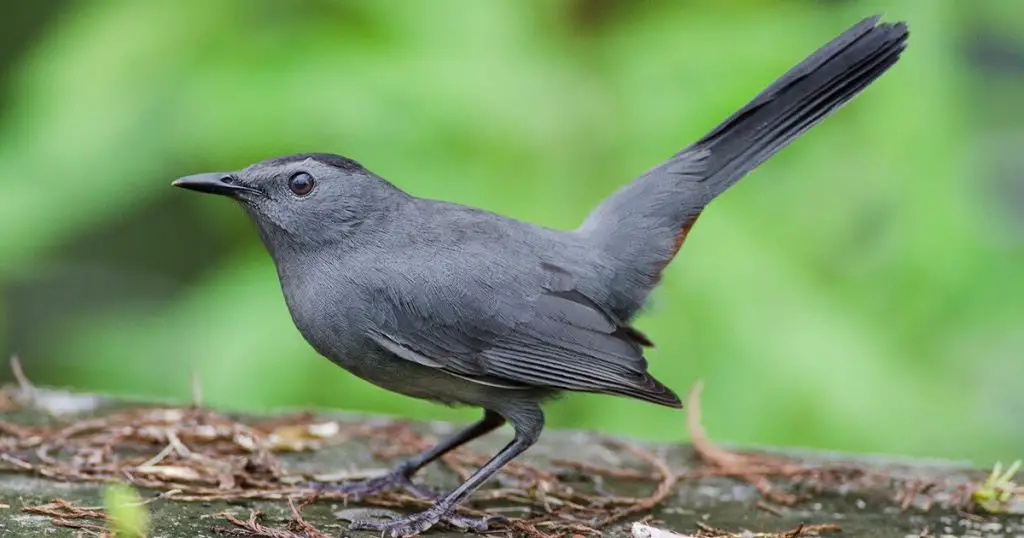
Gray catbirds have an overall dark gray plumage, straight black bill, large black-colored eyes, and bright red undertail feathers. This feathered creature's long, round-tipped tail is more prominent during flight.
Most observers will first notice a gray catbird's slate gray shade, but a closer look shows that the bird also has a black cap. Adult catbirds and their young also look the same.
Aside from its exceptional vocal repertoire, the bird's name is also due to its petulant cat-like, mewing calls.
A gray catbird can even mimic over forty bird songs, machinery sounds, and frog sounds. Such species are well-adapted to close contact with humans, resting in suburban shrubs despite their timid nature. You might even notice its young stopping over a feeding cage in backyards.
This songbird finds undergrowth in woodlands and hedgerows appealing; it favors hollies, wax myrtle, and red cedar trees for their berries and shelter. You might even chance upon this catbird perching on top of the white spruce tree in suburban gardens.
While it might be surprising for some birders, this catbird shows up in backyards if you leave a halved melon there. However, oranges and grape jellies are this bird's favorite fruits.
8. Northern Cardinal
Northern cardinals are among the common backyard birds that breed year-round in New Hampshire and continue to increase their population. Like goldfinches, the northern cardinal finds habitats such as various shrublands crucial for their nesting success.
Such species rarely migrates and won't even roam farther from home. This songbird also frequents open woods, forest edges, and city gardens.
Moreover, many bird enthusiasts find the northern cardinal their favorite winter bird. Its vividly scarlet plumes provide an excellent contrast to the snowy landscapes. The long-tailed songbird features a short, thick bill and a striking pointed crest.
The cardinal is approximately the same size as a red-winged blackbird; these red-winged blackbirds are more common during the warmer seasons. The males have brilliant red plumages with a black mask and beak, while females are pale brown with a reddish shade.
It is an excellent vocalist with a breathtaking song to match its vibrant color. You can attract a norther cardinal to your garden with safflower and black oil sunflower seeds in ground feeders. However, such a bird finds platform feeders more convenient due to their hefty bodies.
Generally, seeds, fruits, and insects comprise this bird's diet, but northern cardinals glean food from nearby trees and shrubs in the wild.
9. American Robin
Wintering American robins stay loyal to their breeding habitats despite chilly grounds and the inaccessibility of worms. An American robin is not a seed eater; hence, it will start to feed on fruits from trees, vines, and shrubs substantially when winter arrives.
Such species are among the common backyard birds thriving in commercial and industrial settings. However, unlike other NH birds, American robins rarely visit bird feeders, but once they do, these birds go to platform bird feeders.
Robins may not rank among the fastest or most agile birds worldwide, but they are exceptionally skilled aviators.
The American robin is a more sizable creature than its British counterpart; this handsome thrush resembles the shape and behavior of other similar species. It has a dark gray back with the front part in a brick-red shade covering the belly but not its blackish face with white streaks.
In comparison, females lack such a vivid appearance that males have. Additionally, many observers find the robin beautifully expressive, whether vocally or through its gestures.
When roosting in deciduous thickets, it sometimes joins flocks, including a cowbird, common grackle, and red winged blackbird. The darkness of a robin's plumage varies; although all subspecies have blacker heads and tails, underparts show a deep red shade.
Fun Fact: The American Robin is likewise a local visitor to the state of Idaho making it one of the birds of Idaho alongside the Song Sparrow and Downy Woodpecker, to name a few!
10. White Breasted Nuthatch
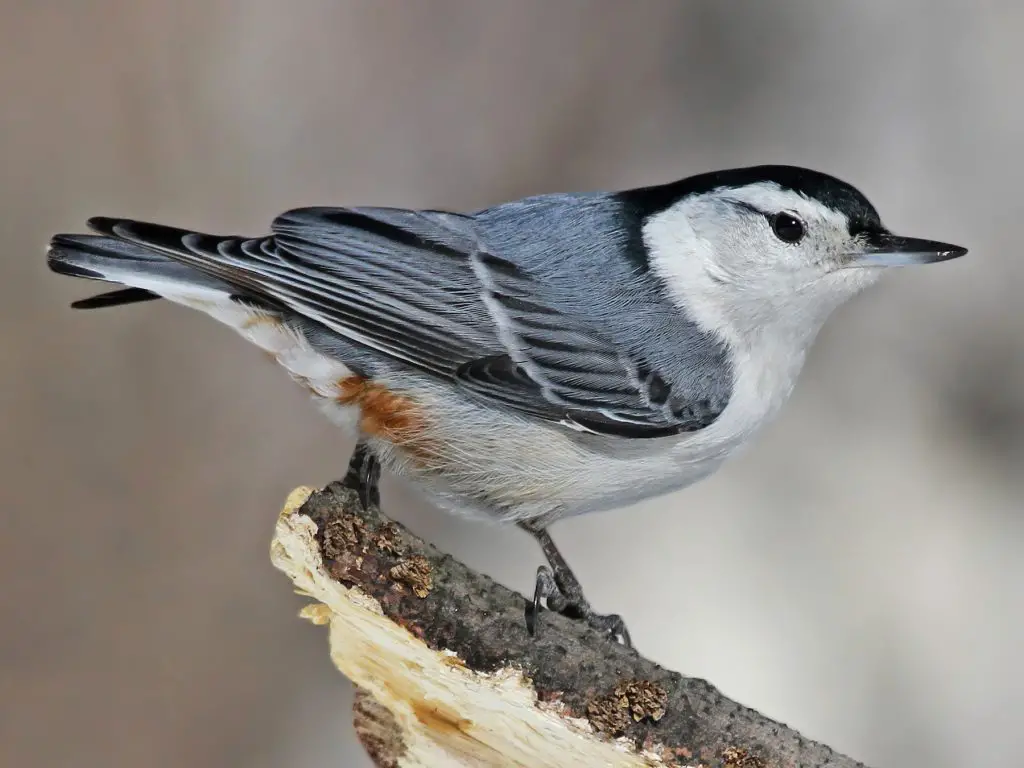
You can characterize a white breasted nuthatch when joining mixed flocks of black-capped chickadees, downy and hairy woodpeckers, and brown creepers with the different foraging methods. The bird is often solitary but joins these flocks in winter.
Birds joining a flock seem to enhance their collective vigilance, helpful for increasing their chances of detecting predators and finding food sources.
Such a nuthatch is easily recognizable with its blue gray back, white underneath, gray wings, and black cap. This small bird has a sizable head and looks like it doesn't have a neck. Its tail is short with a chestnut undertail feathers and has a straight, slightly upturned bill.
If you find New Hampshire bird identification tricky, remember some relevant aspects about these birds aside from their field marks. It helps to remember that this nuthatch almost looks like a chickadee except for its white throat, shape, and movements.
Although white breasted nuthatches seem to give more hints to their observers by their distinct behavior of climbing down tree trunks headfirst. Such gravity-defying stunts of white breasted nuthatches provide many birders find a delightful sight.
Additionally, this species is fond of mixed and deciduous woodlands and suburbian groves, sometimes occurring in riparian forests. You will likely encounter this tree-climbing creature spending more time probing crevices on the trunks of an oak tree than most nuthatches do.
It is among the most common backyard birds in New Hampshire that mainly eat insects or insect eggs, methodically scouring tree barks for them. This nuthatch visits the feeder occasionally, displaying its hearty appetite for meaty seeds despite its affinity for insects.
Fun Fact: Are you clawing for information on another species. Read about the common birds in Oregon!
Watch This!
Frequently Asked Questions
Which among the New Hampshire birds are rare?
Some of the rare birds of NH are the common murre, snowy owl, red crossbill, etc. At the same time, several rarities are starting to reappear, like the ruby-throated hummingbird, sandhill crane, and the black vulture.
New Hampshire Bird Records collects and archives bird sighting documentation statewide. On the other hand, New Hampshire Rare Birds Committee NHRBC reviews the sightings based on the regularity of birds at various seasons of the year.
What are the fall and winter birds of New Hampshire?
In winter, some of the common NH birds you'll see are the chickadee, cardinal, snowy owl, downy woodpecker, tufted titmouse, goldfinch, etc. Additionally, you will likely see migrating raptors during the fall season like the osprey, northern harrier, bald eagle, etc.
Native plants in New Hampshire provide wildlife's basic needs, and as changes occur to the climate, it also affects the birds' habitat. Some species have more time to linger through the colder months, shifting their usual diets to survive the changing temperatures.
What is the official bird of New Hampshire?
In 1957, New Hampshire chose the purple finch to be their official state bird. Despite being a common bird in the northeast regions, no other state has this rosy finch with brown wings as its state bird throughout America.
Male purple finches are eye-catching in their reddish-pink hues, contrary to the brown plumages of the females. This bird is prevalent in NH all year except in winter when it migrates south to survive the cold weather.
What birds love eating sunflower seeds in NH bird feeders?
Northern cardinals, gray catbirds, finches, blackbirds, starlings, nuthatches, mourning doves, common grackles, and sparrows prefer black oil sunflower seeds for their diet.
Black sunflower seeds give birds the necessary fat and protein to provide them with high energy levels. Many birds love eating this seed as it is easier to crack than the striped sunflower seed's shell.
Conclusion
More often than not, our passion for learning more about avian life sparks a lifelong interest in wildlife. Birds are essential to our ecosystem, and the greater our understanding of their existence, the more aware we are of the risks to their existence.
We also develop more effective ways to conserve these lovely feathered creatures through this acquired knowledge. Observing various bird species, feeding them, and providing them a home in our backyards is more than merely an entertaining activity.
We can now contribute to preserving their kind and enjoy many more years of watching the common birds in New Hampshire and many others worldwide.

